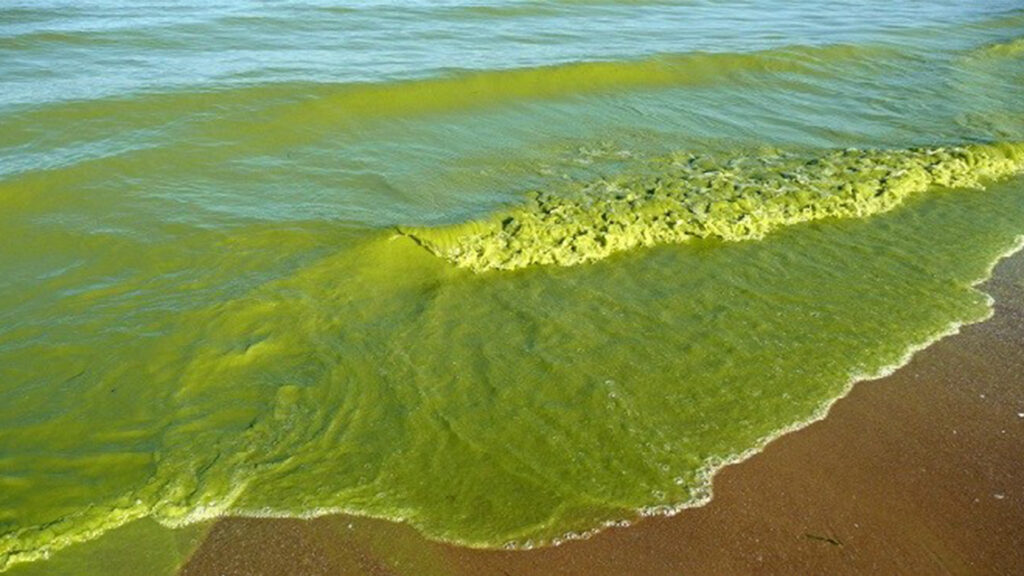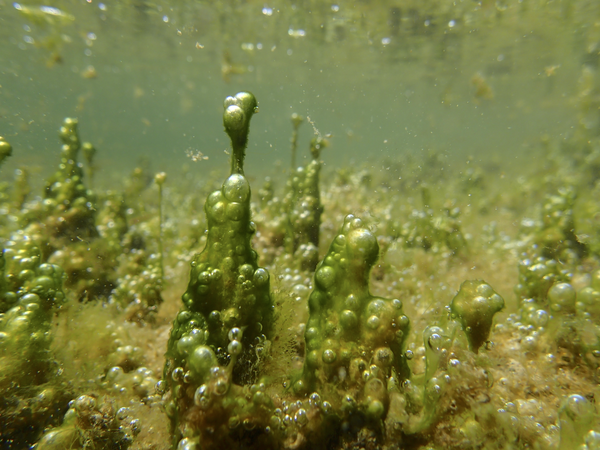Nashwaak Watershed Association
Cyanobacteria
Cyanobacteria are a phylum of aquatic bacteria that obtain their energy from the sun (through photosynthesis). They are often called “blue-green algae” but they are not algae, they are bacteria. They are a natural and essential part of our rivers and lakes and have existed for billions of years. Cyanobacteria are not normally visible, but with the right conditions (warm temperatures, sunlight, flow, and food – nutrients) populations can grow quickly and clump together to form what is called a bloom.
While not all cyanobacteria are harmful, some can produce toxins (cyanotoxins) that are harmful to humans. If you swim in water containing toxins, you may experience skin, eye, and/ or throat irritation. More serious effects, such as gastrointestinal illness, can occur if toxins are consumed.
Surface Blooming Cyanobacteria

Surface blooming cyanobacteria are what people commonly think of when they hear cyanobacteria bloom. They can look different depending on the size of the bloom and species of cyanobacteria. They are most likely to form in warm, slow moving water like lakes and bays.
These blooms can produce cyanotoxins. Most commonly, they produce microcystin which is known to cause skin irritation, gastrointestinal illness, and can cause more severe illness if ingested.
How to spot a bloom?
Blooms most commonly look like green or blue-green scum along the surface of the water but other colours are possible. If the bloom is thick it may appear as though paint or hydroseed has been spilled on the water. Wind/waves can cause blooms to accumulate along the shore.
When a bloom is forming, or wind/wave action has dispersed the bloom, the water can appear cloudy. The water may also appear clear with small green or blue-green globules (balls) or flecks suspended in it.
Fresh blooms can smell like newly mown grass and older blooms can have a foul smell.
Blooms can appear and disappear quickly.
The NB Department of Health issues an advisory if a bloom is noted in a waterbody. Advisories help to inform local recreational water users, so that they can make informed decisions on water use in the affected area. Individuals should avoid swimming and any other recreational water-related activities in areas with blue-green algae blooms.
To learn more about the health impacts and what you can do to protect yourself visit gnb.ca/algae.
Benthic Cyanobacteria
Benthic cyanobacteria may form mats along the bottom of flowing streams and rivers. Benthic mats contain a mixture of cyanobacteria and algae. Unlike a surface bloom, these mats can be present in water that is clear. Some species of benthic cyanobacteria can produce neurotoxins called anatoxins. Human poisonings are unlikely as most people are unlikely to ingest mat material. These toxins can cause skin irritation, gastrointestinal issues, and/or numbness or tingling of fingertips and around the mouth if ingested.
How to spot a Benthic Mat?
Mats are clumps of vegetation that can appear as scum on rocks, mud, or other vegetation along the bottom of the stream or river. They can be dark brown, black, or dark green.
Mats can also have a spongy appearance as they float to the surface.
On the shoreline, mats become dry and can appear light brown or grey. Dried out, washed up mat material may still contain cyanotoxins.
STAY ALERT!
Dogs and wildlife are attracted to the scent of decaying mat material and are at a greater risk of poisoning as they are more likely to ingest fatal doses.
SAFETY TIPS
What to do if you see a cyanobacteria bloom:
- Do not swim or engage in any other recreational activity that may involve contact with water (e.g., water-skiing) in areas where a bloom is observed.
- Keep children, pets and livestock away. They may be more at risk of becoming ill.
- Do not drink the lake water. Boiling the water will not remove toxins.

